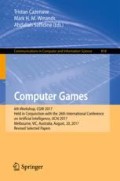Abstract
In recent years, a move evaluation model using a convolutional neural network (CNN) has been proposed for Go, and it has been shown that CNN can learn professional human moves. Hex is a two-player connection game, which is included in the Computer Olympiad. It is important to consider cell adjacency on the board for a better Hex strategy. To evaluate cell adjacency from various perspectives properly, we propose a CNN model that evaluates all candidate moves by taking as input all sets consisting of 3 mutually adjacent cells. The proposed CNN model is tested against an existing CNN model called “NeuroHex,” and the comparison results show that our CNN model is superior to NeuroHex on a \(13\,\times \,13\) board even though our CNN model is trained on an \(11\,\times \,11\) board. We also use the proposed model as an ordering function and test it against the world-champion Hex program “MoHex 2.0” on an \(11\,\times \,11\) board. The results show that the proposed model can be used as a better ordering function than the ordering function created by minimax tree optimization, and we obtained a win rate of 49.0% against MoHex 2.0 (30 s/move).
Access this chapter
Tax calculation will be finalised at checkout
Purchases are for personal use only
References
Anshelevich, V.V.: A hierarchical approach to computer Hex. Artif. Intell. 134(1–2), 101–120 (2002)
Arneson, B., Hayward, R., Henderson, P.: Wolve 2008 wins Hex tournament. ICGA J. 32(1), 49–53 (2009)
Arneson, B., Henderson, P.T., Hayward, R.B.: Benzene (2009–2012). http://benzene.sourceforge.net/
Borgatti, S.P.: Centrality and network flow social networks. Soc. Netw. 27(1), 55–71 (2005)
Browne, C.: Hex Strategy: Making the Right Connections. A. K. Peters, Natick (2000)
Even, S., Tarjan, R.E.: A combinatorial problem which is complete in polynomial space. J. ACM 23(4), 710–719 (1976)
Gale, D.: The game of hex and the brouwer fixed-point theorem. Am. Math. Monthly 86(10), 818–827 (1979)
Hayward, R.B.: Six wins hex tournament. ICGA J. 29(3), 163–165 (2006)
Hayward, R.B.: MoHex wins hex tournament. ICGA J. 35, 124–127 (2012)
Hayward, R.B., Weninger, N., Young, K., Takada, K., Zhang, T.: MoHex wins Hex 11\(\times \)11 and 13\(\times \)13 tournament. ICGA J. (2017, To appear)
He, K., Zhang, X., Ren, S., Sun, J.: Delving deep into rectifiers: Surpassing human-level performance on imagenet classification. In: Proceedings of the 2015 IEEE International Conference on Computer Vision (ICCV 2015), pp. 1026–1034. IEEE Computer Society (2015)
Henderson, P., Arneson, B., Hayward, R.: Solving 8\(\times \)8 Hex. In: Proceedings of the 21st International Joint Conference on Artificial Intelligence (IJCAI 2009), pp. 505–510 (2009)
Henderson, P.T.: Playing and Solving the Game of Hex. Ph.D. thesis, University of Alberta (2010)
Hoki, K., Kaneko, T.: Large-scale optimization for evaluation functions with minimax search. J. Artif. Intell. Res. 49, 527–568 (2014)
Huang, S.-C., Arneson, B., Hayward, R.B., Müller, M., Pawlewicz, J.: MoHex 2.0: A pattern-based MCTS hex player. In: van den Herik, H.J., Iida, H., Plaat, A. (eds.) CG 2013. LNCS, vol. 8427, pp. 60–71. Springer, Cham (2014). https://doi.org/10.1007/978-3-319-09165-5_6
Kingma, D.P., Ba, J.: Adam: A method for stochastic optimization. In: Proceedings of the 3rd International Conference on Learning Representations (ICLR) (2014)
Nash, J.: Some games and machines for playing them. Technical report, D-1164, RAND (1952)
Pawlewicz, J., Hayward, R., Henderson, P., Arneson, B.: Stronger virtual connections in hex. IEEE Trans. Comput. Intell. AI Games 7(2), 156–166 (2015)
Pawlewicz, J., Hayward, R.B.: Scalable parallel DFPN search. In: van den Herik, H.J., Iida, H., Plaat, A. (eds.) CG 2013. LNCS, vol. 8427, pp. 138–150. Springer, Cham (2014). https://doi.org/10.1007/978-3-319-09165-5_12
Pawlewicz, J., Hayward, R.B.: Sibling conspiracy number search. In: Proceedings of the 8th International Symposium Combinatorial Search, pp. 105–112. AAAI Press (2015)
Silver, D., Huang, A., Maddison, C.J., Guez, A., Sifre, L., van den Driessche, G., Schrittwieser, J., Antonoglou, I., Panneershelvam, V., Lanctot, M., Dieleman, S., Grewe, D., Nham, J., Kalchbrenner, N., Sutskever, I., Lillicrap, T., Leach, M., Kavukcuoglu, K., Graepel, T., Hassabis, D.: Mastering the game of go with deep neural networks and tree search. Nature 529(7587), 484–489 (2016)
Takada, K., Honjo, M., Iizuka, H., Yamamoto, M.: Developing computer hex using global and local evaluation based on board network characteristics. In: Plaat, A., van den Herik, J., Kosters, W. (eds.) ACG 2015. LNCS, vol. 9525, pp. 235–246. Springer, Cham (2015). https://doi.org/10.1007/978-3-319-27992-3_21
Tompson, J., Goroshin, R., Jain, A., LeCun, Y., Bregler, C.: Efficient object localization using convolutional networks. In: Proceedings of the IEEE Conference on Computer Vision and Pattern Recognition, pp. 648–656 (2015)
Young, K., Vasan, G., Hayward, R.: NeuroHex: A deep Q-learning hex agent. In: Cazenave, T., Winands, M.H.M., Edelkamp, S., Schiffel, S., Thielscher, M., Togelius, J. (eds.) CGW/GIGA -2016. CCIS, vol. 705, pp. 3–18. Springer, Cham (2017). https://doi.org/10.1007/978-3-319-57969-6_1
Acknowledgments
The authors would like to thank prof. Ryan Hayward for supporting the program development and the fruitful discussions.
Author information
Authors and Affiliations
Corresponding author
Editor information
Editors and Affiliations
Rights and permissions
Copyright information
© 2018 Springer International Publishing AG, part of Springer Nature
About this paper
Cite this paper
Takada, K., Iizuka, H., Yamamoto, M. (2018). Computer Hex Algorithm Using a Move Evaluation Method Based on a Convolutional Neural Network. In: Cazenave, T., Winands, M., Saffidine, A. (eds) Computer Games. CGW 2017. Communications in Computer and Information Science, vol 818. Springer, Cham. https://doi.org/10.1007/978-3-319-75931-9_2
Download citation
DOI: https://doi.org/10.1007/978-3-319-75931-9_2
Published:
Publisher Name: Springer, Cham
Print ISBN: 978-3-319-75930-2
Online ISBN: 978-3-319-75931-9
eBook Packages: Computer ScienceComputer Science (R0)

